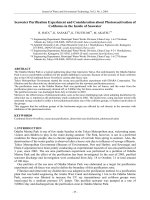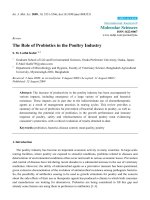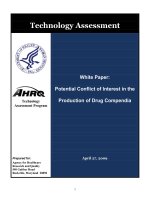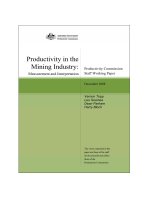Essential Elements of Sanitation in the Beverage Industry
Bạn đang xem bản rút gọn của tài liệu. Xem và tải ngay bản đầy đủ của tài liệu tại đây (3.86 MB, 18 trang )
8
Essential Elements
of Sanitation in the
Beverage Industry
Martha Hudak-Roos and Bruce Ferree
CONTENTS
Introduction
Why Are There Sanitation Needs?
What Are the Current and Future Regulatory Components
of a Sanitation Program?
GMPs
Bottled Water
Juice Regulations
Other Regulations
Summary
What Tools Are Used by the Beverage Industry Today in FulÞlling
Its Sanitation Program Needs?
Cleaning and Sanitizing
Procedures
Other Sanitation Elements
Master Sanitation Schedule
How Is the EfÞcacy of the Program VeriÞed?
Case Studies for Beverages
Conclusion
INTRODUCTION
Sanitation is an essential element for any food processor but is especially
crucial for beverage processors.
Key elements in sanitation include:
TX110_book Page 175 Tuesday, May 6, 2003 9:21 AM
© 2003 by CRC Press LLC
Why are there sanitation needs?
What are the current and future regulatory components of a sanitation
program?
What tools are used by the beverage industry today in fulÞlling its
sanitation program needs?
How is the efÞcacy of the program veriÞed?
Examples of these key elements will be illustrated with case studies. By
following basic principles and incorporating important components such as
management commitment, training, and resources into the sanitation pro-
gram, beverage manufacturers can maintain the efÞcacy of their sanitation
programs, resulting in high-quality, safe beverages that meet reasonable shelf
life expectations.
WHY ARE THERE SANITATION NEEDS?
The word
sanitation
is derived from the Latin “sanitas,” which means
health. Sanitation in the food industry has been applied to the process of
creating and maintaining a wholesome environment in which to make safe
food. It is a broad-based program — encompassing in today’s food industry
a large portion of what are considered “prerequisite” or “universal” food
safety program elements. These are program elements that are plant wide,
as opposed to the Hazard Analysis and Critical Control Point (HACCP)
system, which identiÞes speciÞc process steps as the essential or critical
control points. These universal programs are the second level of the food
safety pyramid (Figure 8.1), with management commitment as the base
and HACCP and continuous quality improvement as the next layer and the
pinnacle, respectively.
FIGURE 8.1
Food safety and quality pyramid.
MANAGEMENT COMMITMENT
PREREQUISITE PROGRAMS
HACCP
CONTINUOUS
QUALITY
IMPROVEMENT
TRAINING
EDUCATION
TX110_book Page 176 Tuesday, May 6, 2003 9:21 AM
© 2003 by CRC Press LLC
Sanitation covers water, air, employee hygiene, equipment cleanliness,
equipment maintenance, facility design and condition, pest control, chemical
control, and a host of other plant-wide needs. By their very nature, sanitation
programs fulÞll the moral and legal obligations to create and maintain
hygienic practices that keep a facility, equipment, and hence the food clean
and wholesome. Companies that have failed in their sanitation programs
have gone down in the annals of history and in the stock market. The recalls
involving Hudson Industries and Bil Mar Foods could have been somewhat
mitigated with enhanced sanitation programs. Outside of the safe food
aspects of sanitation, a clean environment can increase product quality and
shelf life. Reduced yeast and mold in the product and in the environment
are key goals of sanitation, and these organisms affect the quality of products
as well.
As a broad-based program within any plant’s food safety system, sani-
tation must have training, education, and documentation as key elements. It
is unfortunate that we do not require “certiÞed” sanitation managers in the
industry. In many cases, it is difÞcult to get a sanitation crew together.
Sanitation is typically performed during the night shift and involves very
inhospitable environments. The members of the sanitation crew are truly the
unsung heroes of the food safety system.
WHAT ARE THE CURRENT AND FUTURE
REGULATORY COMPONENTS
OF A SANITATION PROGRAM?
The basic sanitation regulation for the beverage industry begins with 21
Code of Federal Regulations Part 110, also known as “Current Good
Manufacturing Practices.” For those beverage manufacturers involved in
international trade, hygiene standards are found in the Codex Alimentarius
Commission’s “General Principles of Food Hygiene.” These two docu-
ments list comparable considerations in producing safe, wholesome bev-
erages in a sanitary environment.
The Good Manufacturing Practices (GMPs) deÞne the regulatory expec-
tations for sanitation. For a beverage processor, the beginning step in sani-
tation is the process of identifying how these expectations are met. We
suggest a table format such as Table 8.1.
In this table, the left column is the Food and Drug Administration
(FDA) provision and the middle column is the GMP text as spelled out
in 21 CFR 110. The last column is where the plant/facility can list the
procedures or programs that are used to cover the regulatory need. Such
a matrix can identify any GMP area that is not fully addressed. It can
also help to consolidate procedures, if you Þnd within the matrix many
TX110_book Page 177 Tuesday, May 6, 2003 9:21 AM
© 2003 by CRC Press LLC
TABLE 8.1
U.S. FDA GMP Matrix Example
GMP Item Regulatory Guidance
Food Safety
Program
110.10 Personnel
The plant management shall take all reasonable
measures and precautions to ensure the
following.
(a) Disease
Control
Any person who, by medical examination or
supervisory observation, is shown to have, or
appears to have, an illness, open lesion,
including boils, sores, or infected wounds, or
any other abnormal source of microbial
contamination by which there is a reasonable
possibility of food, food-contact surfaces, or
food-packaging materials becoming
contaminated, shall be excluded from any
operations which may be expected to result in
such contamination until the condition is
corrected. Personnel shall be instructed to
report such health conditions to their
supervisors.
(b) Cleanliness All persons working in direct contact with food,
food-contact surfaces, and food-packaging
materials shall conform to hygienic practices
while on duty to the extent necessary to protect
against contamination of food. The methods
for maintaining cleanliness include, but are not
limited to:
(1) Wearing outer garments suitable to the
operation in a manner that protects against the
contamination of food, food-contact surfaces, or
food-packaging materials.
(2) Maintaining adequate personal cleanliness.
(3) Washing hands thoroughly (and sanitizing
if necessary to protect against contamination
with undesirable microorganisms) in an
adequate handwashing facility before starting
work, after each absence from the work station,
and at any other time when the hands may have
become soiled or contaminated.
TX110_book Page 178 Tuesday, May 6, 2003 9:21 AM
© 2003 by CRC Press LLC
procedures that are addressing the same need. For international compa-
nies, the Codex General Principles of Food Hygiene are analogous to the
FDA GMPs and are an excellent resource as the base reference for any
company’s sanitation program.
GMP
S
The General Provisions within the GMPs start with one of the most important
aspects of hygiene, personnel hygiene. Plant management must have a pro-
gram in place to ensure that personnel are healthy and not likely to be the
source of abnormal microbial contamination. Also, personnel working with
food or packaging must maintain a degree of cleanliness that includes clean
outer garments, good personal hygiene, and adequate handwashing. Jewelry
is not permitted. Gloves, if used, must be intact, clean, and in sanitary
condition, as well as made from an impervious material. Hair restraints are
required. Storage of personal items is limited to areas other than where food
is exposed or equipment and utensils are washed. Personal habits are also
regulated: no gum chewing, eating food, drinking beverages, or using tobacco
where food is exposed or equipment is washed. Finally, the regulatory guid-
ance concludes with the statement, “…taking necessary precautions to pro-
tect against contamination of food, food-contact surfaces, or food packaging
materials with microorganisms or foreign substances including, but not lim-
(4) Removing all insecure jewelry and other
objects that might fall into food, equipment, or
containers, and removing hand jewelry that
cannot be adequately sanitized during periods in
which food is manipulated by hand. If such hand
jewelry cannot be removed, it may be covered
by material which can be maintained in an intact,
clean, and sanitary condition and which
effectively protects against the contamination by
these objects of the food, food-contact surfaces,
or food-packaging materials.
(5) Maintaining gloves, if they are used in food
handling, in an intact, clean, and sanitary
condition. The gloves should be of an
impermeable material.
TABLE 8.1 (CONTINUED)
U.S. FDA GMP Matrix Example
GMP Item Regulatory Guidance
Food Safety
Program
TX110_book Page 179 Tuesday, May 6, 2003 9:21 AM
© 2003 by CRC Press LLC
ited to, perspiration, hair, cosmetics, tobacco, chemicals, and medicines
applied to the skin.”
The General Provisions also cover education and training. The guidance
suggests that personnel responsible for identifying sanitation failures or food
contamination should have a background of education or experience to
provide a level of competency necessary for the production of safe food.
Food handlers should receive (in the authors’ opinion,
must
receive) appro-
priate training in proper food handling techniques and food protection prin-
ciples and should be informed of the dangers of poor personal hygiene and
unsanitary practices. Supervisors, according to the GMPs, are responsible
for ensuring compliance.
The grounds of the manufacturing site should allow for proper storage of
equipment and removal of waste. Weeds and grass should be kept cut, and the
yard, roads, etc., maintained. Reducing pest harborage and attractants is part
of this requirement: drainage and waste disposal must be adequate. All unused
process piping must be stored up off the ground. The building also must be
under control. SufÞcient space for equipment and storage must be available.
The design of the facility must be effective to permit proper precautions for
reducing the potential for contamination: i.e., location, time, partition, airßow,
and enclosed systems. Included in this section of the GMPs is the requirement
to protect food in outdoor bulk fermentation vessels by coverage, controlling
areas over the tanks, checking on a regular basis for pests, and skimming.
Building Controls go on to cover ßoors, walls, ceilings (construction,
materials, cleanliness), lighting, ventilation, and screening for pests. For
sanitary operations, the GMPs require that the building and equipment be
maintained in a sanitary condition. Cleaning compounds and sanitizing
agents must be safe and adequate for use. (
Note:
the GMPs do not deÞne
acceptable cleaning and sanitizing compounds. These are deÞned in 21 CFR
Part 178.) Toxic compounds must be controlled so as not to contaminate
food, contact surfaces, or packaging. Pest control is required within this
section as well. Sanitary operations also include the cleaning and sanitizing
of food contact surfaces.
Sanitary Facilities and Controls covers water supply, plumbing, sewage,
and toilets. Processors who use boilers to create steam should become famil-
iar with this section as well as Part 173 Subpart D — Secondary Direct Food
Additives, SpeciÞc Usage Additives.
Finally, this section covers handwashing. Good handwashing includes
hot water, sanitary towels, and refuse receptacles for waste towels. Signs
that indicate that hands must be washed and how to wash must be posted
and must be understood easily by the staff. Fixtures with foot- or knee-
activated pedals that are designed to protect against recontamination of clean
hands are also important.
TX110_book Page 180 Tuesday, May 6, 2003 9:21 AM
© 2003 by CRC Press LLC
Equipment and Utensils are part of the GMPs. According to the regula-
tion, “The design, construction, and use of equipment and utensils shall
preclude the adulteration of food with lubricants, fuel, metal fragments,
contaminated water, or any other contaminants. All equipment should be
installed and maintained as to facilitate the cleaning of equipment and all
adjacent areas.” This section covers aspects important to the beverage indus-
try such as smooth welds and the cleanliness of holding, conveying, and
manufacturing systems (closed and automated). It covers equipment instru-
mentation (thermometers, pH, acidity, etc.) and the need to accurately and
adequately maintain these devices. This is an important section for review.
Production and Process Controls covers operations. This section has some
key elements, including “Appropriate quality-control operations shall be
employed to ensure that food is suitable for human consumption and that
food packaging materials are safe and suitable” and “Overall sanitation of
the plant shall be under the supervision of one or more competent individuals
assigned responsibility for this function.” There are three areas speciÞc to
this section: Raw Materials, Manufacturing Operations, and Warehousing.
The Raw Materials section requires that raw materials be inspected, segre-
gated, or otherwise handled to ensure that they are clean and suitable for
processing. This section also requires that water used for washing or rinsing
be safe and of sanitary quality. Where water is reused for washing, it cannot
increase the level of contamination of the food. In today’s manufacturing
environments, water reuse (recycling) is a key element in food sanitation.
The Codex Committee on Food Hygiene has developed a text on the safe
reuse of water that can be found on the Codex Web site. Those in the beverage
industry must be cognizant of water safety issues, including
Cryptosporidium
(chlorine resistant),
Giardia
, and other protozoa. Rinsing and sanitizing
equipment right before use with chlorinated water might not provide for safe
food contact surfaces.
Other points of interest within Raw Materials include:
“Material scheduled for rework shall be identiÞed as such.”
Check your rework protocols to ensure that they meet this re-
quirement.
“Liquid materials received and stored in bulk shall be held in a manner
that protects against contamination.”
Liquid bulk items in bulk containers can be protected from contam-
ination by ensuring proper ventilation and by reviewing the con-
dition of agitators routinely. Protection from contamination also
means that CIP (clean-in-place) and product loops in distribution
systems cannot be cross-connected. This is especially important
in the beverage industry where most items are cleaned with CIP
TX110_book Page 181 Tuesday, May 6, 2003 9:21 AM
© 2003 by CRC Press LLC









